Behind the Scenes: My Life on MarsLife on Mars began for me in the spring of 2002, when I made the fateful and largely clueless decision to commit myself to making a NOVA about the Mars Exploration Rover (MER) mission. It was fateful because it turned out well—I ended up making not one but two films, "MARS Dead or Alive" and "Welcome to Mars." It was clueless because I had no idea what I was getting into or how great the odds were that I'd wind up with nothing. It was not a difficult decision. For me, as for many others, Mars is irresistible. It has the mythic pull of an alien world, but at the same time it's a familiar place, not far removed from the landscapes of southern Utah. I also knew that the MER mission had great potential for drama. After two embarrassing failures in 1999, one of which was notorious for a fatal mix-up between English and metric units, NASA was preparing to take what could be its last shot at Mars. Another failure, for whatever reason, might kill the Mars Program altogether. There was also a textbook protagonist in the person of Steve Squyres, the scientist who had spent 10 years chasing the dream of sending robot geologists to Mars (see Man on a Mission) and who now faced a series of increasingly difficult challenges leading to the climax of landing on Mars. And it didn't hurt that he was the most articulate and charismatic space scientist to come along since Carl Sagan, his former mentor. Tension and tediumFull of innocent hope and enthusiasm, I made my first visit to NASA's legendary Jet Propulsion Laboratory (JPL) in Pasadena, Calif. By the end of a grueling eight-hour tour, I realized that while there may be nothing more exciting than a mission to Mars, there are many things more exciting than watching spacecraft being built. It was a little more than a year before launch, and the rovers did not yet exist; there were just some rather unimpressive parts in various stages of assembly. I was told to stay at least a yard away from them and not make any sudden movements that might startle the guy with the socket wrench and possibly cause a very expensive accident. I was told that there would be lots of important tests coming up over the next nine or 10 months, but the schedule was a work in progress, and no one seemed to know exactly what was going to happen when. Until they had at least one rover built, there wasn't much to test anyway. The engineers were friendly, and most of them seemed open to the idea of being filmed, but I soon learned that they were also behind schedule, over budget, overworked, and one unconverted metric unit away from a mass panic attack. The first few shoots were discouraging. With the exception of a tense confrontation between Squyres and the engineers during a shock test of the Mini-TES infrared spectrometer (see Anatomy of a Rover for more on this instrument), I didn't seem to be getting much. Things happened at a very slow yet unpredictable pace. I tried to arrange shoots for times when something interesting would be going on, but nothing ever happened when it was supposed to. It was rare to see someone actually driving a screw. The idea of having a film crew working around flight hardware in the clean rooms made the project managers nervous. We were on probation, and if anyone felt that we presented the slightest hazard or distraction, our access would be cut off. We were very, very careful. Along for the rideEventually the engineers got used to us and things loosened up a bit. Many of them went out of their way to be helpful and let me know about the problems they faced. There were struggling to fit a big rover inside a little lander—or, as one of them put it, "trying to fit ten pounds of s**t in a five-pound bag." There was a strict limit on mass, but everything was getting heavier. They were having lots of trouble with the airbags and the parachutes. There was no guarantee that the rovers were going to work once they were built, or that they would survive the gauntlet of tests that awaited them. Every subsystem would have to pass a series of intensely critical independent reviews. Upper management was fully prepared to scrub the mission if there was any doubt about anything. Better that than suffer another failure on Mars, they reasoned. And the deadline was unmovable. If they weren't ready to go by the time the launch window opened in the summer of 2003, that was it. No second chance. Once again I had underestimated the prospects for disaster. These obstacles and the marathon struggle to overcome them became the engine that drove the story in "MARS Dead or Alive." Even so, I didn't fully appreciate until a couple of months into the project that not launching at all was a distinct possibility. That moment came during the first parachute tests in the wind tunnel when the chute "squidded" instead of popping open as expected. The engineers were stunned. Time was running out. If they couldn't fix this problem quickly the mission would be over. And if they couldn't fix it, I realized, my film was just as doomed as their mission. From then on I was no longer a neutral observer. I was along for the ride, and if they couldn't get off the ground, neither would the film. Fortunately for all of us, they solved the squidding and moved on. It was an impressive display of grace under pressure, and as it turned out, a nice climax to Act II of "MARS Dead or Alive." White knucklesBy the end of January 2003, most of the big hurdles seemed to have been cleared, at least as far as I knew. The rovers were shipped to Florida for launch, and I went into the editing room with my team to start putting the program together. We would shoot the launches in June but didn't expect much more excitement until the landings in January 2004. Once again I had underestimated the prospects for disaster. Just before the launch window opened the engineers detected a possibly fatal electrical problem in the rovers. Spirit, the first of the two rovers sent to Mars (Opportunity would be sent a few weeks later), was ready to go to the launchpad. They had very little time to figure out what was going on, fix it if possible, and convince NASA's top brass that the problem really was fixed. Otherwise, as Squyres put it, the rovers would end up in the National Air and Space Museum—a profoundly anticlimactic ending for the mission and the film. I tried to imagine how the film would play if this was the end of the story, and it was not good. But in what by now had become classic MER style, they nailed it down with just a few days to spare, and the rovers were cleared for launch. Now I was not only aware of the potential for trouble, I expected it. The countdown began for Spirit's launch, and my stomach began to churn. The rocket could blow up on the launchpad. Or take an unexpected detour into the Atlantic Ocean. Or the second stage boosters might fail. Or the rover might get fried by a solar storm on the way to Mars. The possibilities were endless. At last I understood why everyone was so uptight. It really wasn't going to be over until it was over, and the worst was yet to come. Through the summer and fall of 2003, Mars was getting bigger and brighter in the sky every night, thanks to the close encounter between Earth and the Red Planet that happens every 26 months as our orbits line us up briefly in a straight line with the sun. It's kind of like a full moon, but in this case it was a full Mars, blazing red. This fleeting proximity was what made the mission possible. I was working on the film all day and thinking about it all night. If I forgot about it for a moment, all I had to do was look up. High-wire actFrom the beginning we knew that the first rover launched would be landing on Mars the night of January 3, 2004. This presented an opportunity for NOVA to try something they'd never done before—a live (or near-live) climax to an otherwise finished program. "MARS Dead or Alive" was about the difficulty of getting to Mars, and it would come down to surviving the final six minutes of the trip, the dreaded Entry, Descent, and Landing phase, when the rover was on its own and all the troublesome systems involving the parachute, airbags, etc., would come into play. We knew exactly when it would happen—11:29 p.m. Eastern Time on Saturday night, which was too late for a live broadcast. The closest we could get was Sunday night, about 21 hours after Spirit was expected to land. We would shoot Saturday night, edit on Sunday, and satellite the final two minutes of the show back to WGBH in time for broadcast Sunday evening. The problem was that there was no guarantee that we would get confirmation of landing by then, successful or otherwise. We might find ourselves with nothing to say other than "we're still waiting to hear." When I told Squyres what we were doing, he called it "a high-wire act worthy of MER." Flattering, but not reassuring. In the final weeks before landing, NASA moved into JPL and locked the place down. No press would be allowed beyond the ropes until further notice. Inside, the drama continued. Dust storms on Mars had stirred up the atmosphere, raising the temperature and thinning the already thin air at the altitude where the parachute would open. With the NASA bosses watching closely, the landing team weighed the options and finally decided to open the parachute at a higher altitude to give it more time to slow the spacecraft in the thinned-out atmosphere. Popping the chute early meant they'd be opening at a higher velocity than they'd like, but they believed they had the margin to make it work. While this was going on at JPL, the British lander Beagle 2 was attempting its own landing on Mars, without the adjustment. It didn't make it. There's no official verdict on what happened, but the thinner-than-expected atmosphere is a likely culprit. Landing nightOn landing night NOVA's crew huddled in one of a dozen production trucks in the JPL parking lot. NASA-TV was providing the video from mission control, and we were all plugged into the feed. Steve Squyres and Adam Steltzner, MER's Lead Landing Systems Engineer, gave us a few minutes on camera just before landing. They were pretty wound up. After three years of micromanaging every detail, they had no more control over what would happen next than we did. When the time finally arrived, the landing sequence unfolded as though it had been scripted for television, right down to the premature celebration of success followed by 15 minutes of agony waiting to hear from the spacecraft. From then on everything exceeded expectations. Within a few hours Spirit was sending back pictures. It was now well after midnight in California. The engineers and the rover had done their jobs. We needed some sleep before finishing ours. My great fear is that Opportunity will find dinosaur bones the night before broadcast. Sunday morning I sat down with the editor and four hours of tape from the night before. We had only seven hours to put together the final two minutes of a show I'd been working on for a year and a half. We skimmed the tapes at double speed, making quick notes. Then we put the piece together in one pass, knowing that there would be no time for revision. The narrator arrived at 2:30 p.m. to voice the track. By 3:30 we were sending the finished piece by satellite back to WGBH in Boston, where the post-production crew attached it to the rest of the program and sent out the national feed an hour later. By the time we left JPL the show was already airing on the East Coast. Later that night we watched the Pacific Time broadcast. It was all there. I went to bed and slept soundly for the first time in a long while. Welcome to MarsFor the first month after Spirit's landing a large press corps was camped out at JPL, and everyone wanted to get inside to see what was going on. But there were too many of us, so we were all locked out for the first few weeks. Fortunately for me, JPL's in-house cameraman, John Beck, was shooting everyday, covering things like Spirit's communication breakdown, and I later got access to his footage. By the end of January I was back inside with my own crew to follow the action through February and March, when Opportunity made its big discoveries. Unlike the story of getting to Mars, the story of being on Mars has no definitive ending yet. After the rovers more than tripled the original mission objective of 90 martian days ("sols") in October, NASA extended the mission for another six months. As of this writing (November 2004) the rovers are still going strong despite a few aches and pains. "Welcome to Mars" is finished and ready to air. My great fear is that Opportunity will find dinosaur bones the night before broadcast.
In this business there's nothing more exciting or stressful
than following a developing story, especially one that can end
abruptly at any moment. It's the unpredictability that makes
the story interesting, so I'm not complaining. I'm glad I had
a chance to experience some small measure of what the people
of MER were going through. I know there was a lot that I
didn't see. I've heard truly hair-raising stories about close
calls that have never been reported, and I'm sure there were
others that I haven't heard about. For those heart-stoppers
we'll all just have to wait for Steve Squyres' book. |
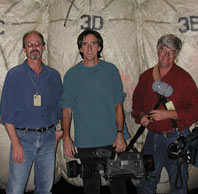
Producer Mark Davis, cameraman Brian Dowley, and soundman George Shafnacker at the NASA Plumbrook test facility during airbag tests in October 2002 
Davis was told to "not make any sudden movements that might startle the guy with the socket wrench and possibly cause a very expensive accident." 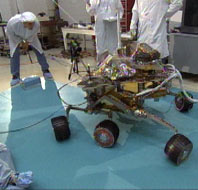
Davis and his crew were "very, very careful" in the clean rooms. One mistake and they could be told to hit the road. 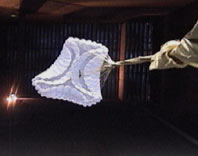
The spacecraft's parachute "squids" during a critical test. 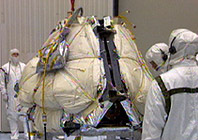
MER engineers became expert at troubleshooting last-minute problems with the rovers, one of which is shown here all wrapped up and ready to go. 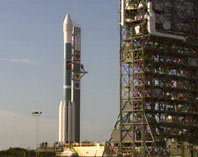
Despite some eleventh-hour worries, both launches went off without a hitch. 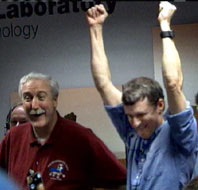
With NASA Administrator Sean O'Keefe at his side, principal investigator Steve Squyres, arms raised, celebrates the first contact from the Spirit rover shortly after its successful landing on January 3, 2004. |
|
|
|
|
Mark Davis produced both "MARS Dead or Alive" and "Welcome to Mars." For the former film, Davis won the 2004 Science Journalism Award for television from the American Association for the Advancement of Science. Mars Home | Send Feedback | Image Credits | Support NOVA |
© | Created November 2008 |

